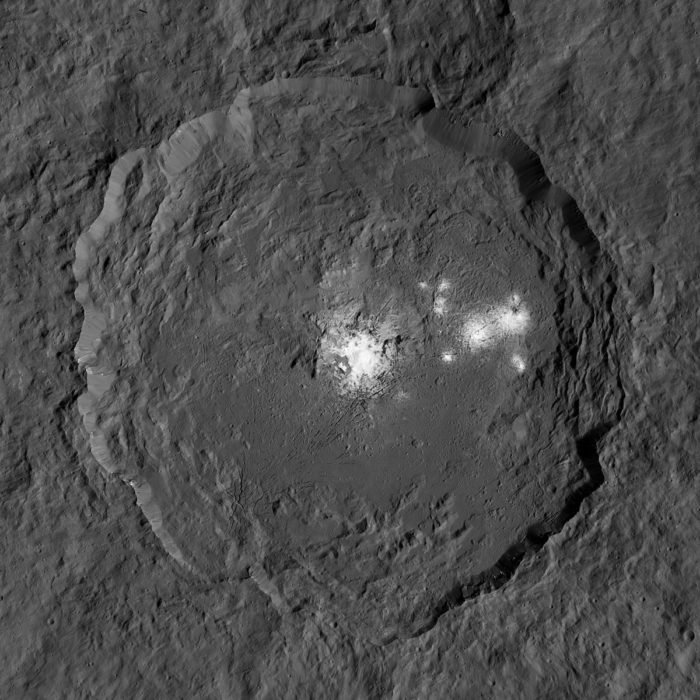Aug 11 2020
Ceres an Ocean World
 It seems we can add the dwarf planet, Ceres, to the list of ocean worlds in the solar system. These are planets or moons that have vast oceans beneath their surface – Earth is the only world with stable liquid water on its surface. These worlds are of particular interest because liquid water means the potential for life.
It seems we can add the dwarf planet, Ceres, to the list of ocean worlds in the solar system. These are planets or moons that have vast oceans beneath their surface – Earth is the only world with stable liquid water on its surface. These worlds are of particular interest because liquid water means the potential for life.
Ceres is the largest object in the asteroid belt between Mars and Jupiter. When it was first discovered it was categorized as a planet. Then it was discovered that it was the largest member of a belt of objects, and so it was “downgraded” to an asteroid (although the king of the asteroids). But then in 2006 the International Astronomical Union (IAU) famously created the new category of dwarf planet. Pluto was then demoted from full planet status to dwarf planet, but Ceres was upgraded also to a dwarf planet. These are worlds that orbit the sun, are not satellites, are large enough to pull themselves into a rough sphere, but have not cleared out their orbit of other large objects.
The recent study, based on data from the Dawn probe which did close up high-resolution imaging of Ceres (coming as close as 35 km) strongly suggests that there is at least a regional subsurface briny ocean on Ceres. The bright spot in Occator crater, which formed 22 million years ago from an impact, appears to be salt left behind by salty water leaking to the surface at the site of impact. The water then evaporated, leaving behind the highly reflective salt. This bright spot is a very unusual feature, that quickly grabbed attention when the Dawn probe images were first coming back.
At the very least, therefore, there is a large salty ocean beneath that crater. It is unknown if the ocean is regional or global, but even if regional it still qualifies Ceres as an ocean world. It joins the list which includes the moons of Jupiter Europa, Ganymede, and Callisto, the moons of Saturn Enceladus and Titan, and possible (still unconfirmed) Saturn moon Mimas and the moon of Neptune, Triton. Astronomers believe that the subsurface ocean of Ceres must be slowly freezing. Moons of gas giants have tidal forces to produce internal heat and keep their oceans liquid.
Onto the big question – what is the probability that life will exist in one or more of these ocean worlds? Many believe finding out the answer to this question should be a top priority for NASA, and I agree. This is perhaps the most pressing scientific question that space exploration can answer.
One way to approach this question is to find out if life on Earth can survive in environments similar to these subsurface oceans. Like with Ceres, it is probable that such oceans are very salty, and not just with sodium chloride but with other salts. Some of those salts, such as perchlorates which have been found in Martian regolith, are toxic to Earth life. This is where extremophiles come into play.
Extremophiles are organisms that can live in extreme environments. They are a way for us to test the ultimate environmental limits of life, at least life related to known life on Earth. Bacteria and archaea are pretty much everywhere on Earth. They have found their way into every environment, pushing the limits of life. This is a good test – how far has life been able to push into these extreme environments? When it comes to salty water, the answer appears to be – all the way.
Extremophiles that can tolerate high salinity are called halophiles. Researchers have found halophiles living in the saltiest lakes on Earth, including the Dead Sea and the Great Salt Lake. They have recently even found them in environments with high levels of perchlorates, which is a good sign for possible life on Mars. Extreme halophiles can live in water with 30% salt.
There is, in fact, only one location on Earth with liquid water where scientists have found no life, in Dallol Ethiopia. That lake, however, is not only very salty, it is extremely hot and acidic as well. It takes this extreme trifecta to finally find the limits of extremophiles. But there does not appear to be any water on earth that is simply too salty for life. There is also nothing too cold for extremophiles – even the icy waters of Antarctica contain bacteria, comfortable at a single degree above freezing.
It is therefore at least plausible that life can exist in the frigid briny water beneath the surface of any of these ocean worlds. The challenge, of course, it getting to this water without introducing any contamination. Drilling would be difficult, and I don’t expect that to happen anytime soon. Perhaps the best bet is to sample water that is ejected from the subsurface oceans. Some of these worlds are geologically active. They have ice volcanoes or geysers that occasionally spew liquid water into space or onto the surface of their world. A probe could theoretically grab some of this water, even as it crystalizes, and look for the markers of organic life.
Discovering life elsewhere in our own solar system would be one of the greatest scientific discoveries of all time. It would be the first second data point in terms of life in the universe. The implications would be profound – and worth every penny NASA spends making such a discovery.






